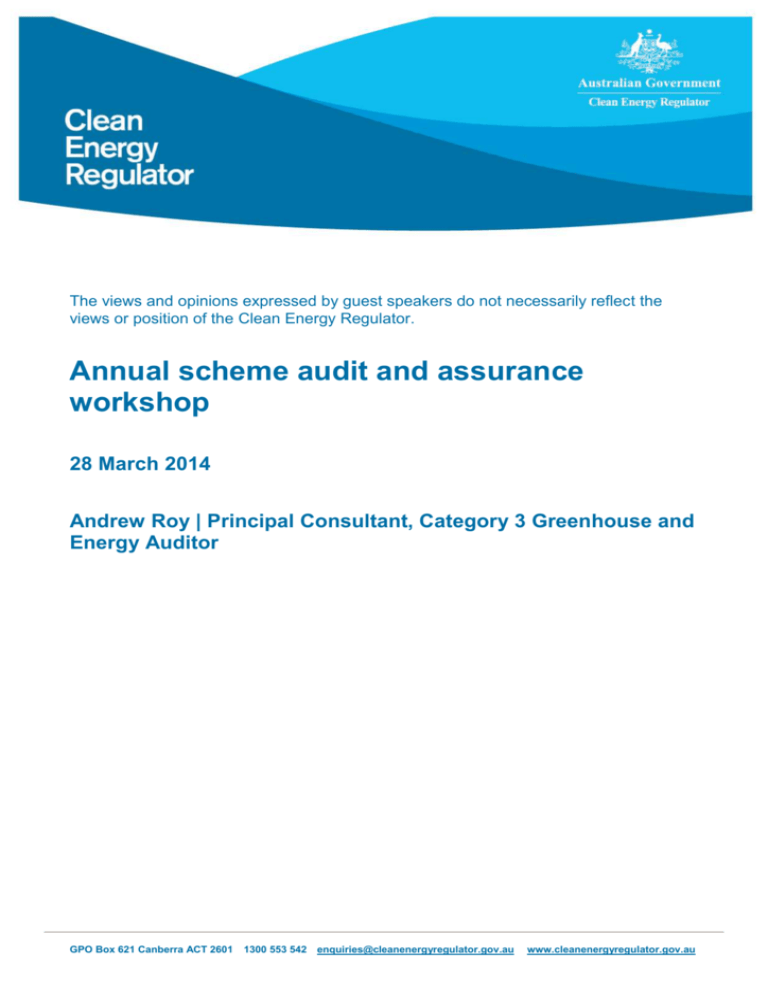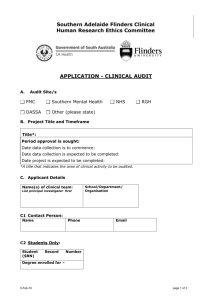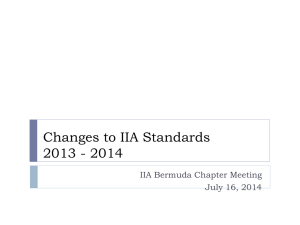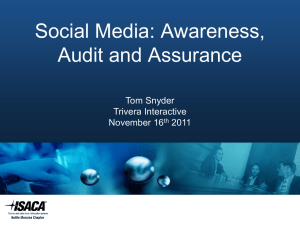Experiences in CFI Assurance - GHD
advertisement

The views and opinions expressed by guest speakers do not necessarily reflect the views or position of the Clean Energy Regulator. Annual scheme audit and assurance workshop 28 March 2014 Andrew Roy | Principal Consultant, Category 3 Greenhouse and Energy Auditor GPO Box 621 Canberra ACT 26011300 553 542enquiries@cleanenergyregulator.gov.au www.cleanenergyregulator.gov.au Risk management and judgement are the keys to a successful engagement An experience of their practical application Case studies Reforestation & afforestation two forest strata with sites across two states permanent single species block plantings required substantial field based sampling to collect the required data: » destructive sampling of a subsample of live trees » laboratory analysis of key parameters » development of allometric function » full inventory to collect biomass sampling across the project Savannah burning extensive project area data collected and managed remotely calculations undertaken using modeling tool (SavBat) Risk and CFI projects the object of a CFI project is to create ACCUs the objective of a CFI engagement is to provide reasonable assurance that: » the project meet requirements of the Methodology Determination » the Offset Report has been prepared in accordance with s76 of the CFI Act » the project was undertaken in accordance with the s27 Declaration, the Methodology and the CFI Act risk is the effect of uncertainty on objectives (AS/NZS ISO 31000:2009) GPO Box 621 Canberra ACT 26011300 553 542enquiries@cleanenergyregulator.gov.au www.cleanenergyregulator.gov.au The broader risk context Audit risk Audit risk is simply the risk that the audit team leader will issue the wrong assurance conclusion. For example, the risk that an adverse conclusion is not reached because the audit team leader fails to detect material misstatement(s) in the audited body’s reported emissions, energy, offsets, production or process flow diagrams or detect material non‑ compliance with requirements or activity descriptions, which are being assured. Audit risk is therefore the risk to the audit team leader’s firm of signing off on an incorrect assurance conclusion. For example, the audit team leader may issue an unqualified assurance conclusion when a qualified or an adverse assurance conclusion should have been issued. This might occur where a material misstatement exists in the reported information or a material non‑ compliance with requirements exists, but remains undetected. This may be due to inadequate planning, resulting in insufficient procedures being performed to gather sufficient appropriate evidence. Audit risk is unavoidable in practice, as it is not possible for an audit team leader to obtain absolute assurance that all material misstatements or non-compliance have been detected. However, it can be mitigated through effective and thorough preparing, planning, performing and reporting procedures, as outlined in this handbook. Inherent risk Inherent risk can be expressed as the inherent likelihood of there being material misstatements in the emissions, energy, offsets, production or other information reported, or there being non-compliance with relevant requirements, despite the impact of any mitigating controls implemented by the audited body. Inherent risk is dependent on a combination of wide-ranging factors, from those that affect the audited body as a whole (for example, the scope and complexity of the operations) to those that affect single measurements or calculations (for example, the reliability of electricity meters or emissions estimates). Detection risk Detection risk is the risk that the audit team leader will not detect a misstatement or non‑ compliance that exists that could be material, either individually or when aggregated with other misstatements or non-compliance. Detection risk increases if assurance procedures are performed in an ineffective manner, or if procedures are designed poorly. For example, an audit team leader is reviewing the accuracy of an emissions calculation, but has not reviewed or tested the source data supporting the calculation. In this instance, detection risk would increase as the calculation may be performed accurately, but if the underlying data is unreliable (for example, due to transcription errors in supporting GPO Box 621 Canberra ACT 26011300 553 542enquiries@cleanenergyregulator.gov.au www.cleanenergyregulator.gov.au spreadsheets or unreliable estimates made in preparing the input data), the audit team leader could miss a material misstatement in the reported emissions and energy information. Control risk Control risk is the risk that a misstatement or non-compliance could occur and that it could be material and will not be detected and corrected or prevented by the audited body’s internal control systems. For example, a transcription error during manual data entry from a spreadsheet into a reporting tool such as the Emissions and Energy Reporting System (EERS), which has not been picked up by the manual review of the EERS submission performed by management. Common issues It is highly likely that through this process the audit team leader will identify either significant risks, or areas of the assurance engagement where there are likely to be significant risks. Rather than seek to address these risks now, the audit team leader should use the risk assessment process to design the mix of assurance procedures necessary to address the identified risks during the performing stage. These assurance procedures are then documented in the assurance engagement plan. See section 5.3.9 of this handbook for further guidance on the assurance engagement plan. Professional judgement in a risk context Professional judgement: is the ability to draw meaningful and accurate conclusions, give opinions and make interpretations based on observations, knowledge, experience, literature and other sources of information; and is based on facts and objective evidence, as well as experience, which includes some subjectivity. GPO Box 621 Canberra ACT 26011300 553 542enquiries@cleanenergyregulator.gov.au www.cleanenergyregulator.gov.au An approach to managing judgement and risk assurance engagement plan risk assessment process identifies the audit, inherent, control and detection risks in the audit, professional judgement » exists within a risk context » occurs within the framework of identified risks and the sampling and testing plan (or risk treatment) » is intended to bring certainty to areas of uncertainty at the boundary of audit evidence collection and evaluation » is not a replacement for the proper management of risk or formation of a competent test plan Competence critical for good professional judgement Audit team competence includes personal attributes » ethical, observant, perceptive, tenacious, decisive, self-reliant, organised skills » plan, organise, lead, prepare the conclusion knowledge » forest sector, measurement & monitoring experience, quality processes, records management, complex methodologies Some specific risks for CFI vegetation projects dealing with natural systems that change over time monitoring requires manual collection of field data accuracy / uncertainty around data are not quantified quality assurance process give greater confidence but variability still occurs methodology determinations vary in complexity, how prescriptive and audit effort need for professional judgement reduced by prescriptive nature of some methodology determinations GPO Box 621 Canberra ACT 26011300 553 542enquiries@cleanenergyregulator.gov.au www.cleanenergyregulator.gov.au Vegetation project issues requiring particular attention compliance with eligibility requirements of the Methodology Determination accurate input data and supporting records calculation of net abatement report compliance record keeping Professional judgement in a CFI vegetation project context is a site visit required? re-measurement of field data – what variation in the data is acceptable? at what scale is variation acceptable – tree, plot, estate? how to deal with ‘must’ statement in the Methodology Determination? Is it material? data control – is opportunity for error or fraud minimised? monitoring equipment– is calibration appropriate? record keeping – provides sufficient audit evidence to support requirements of the Methodology Determination Some final thoughts Professional judgement Professional judgement informs decision making includes subjectivity, but not where it contradicts objective reality is a rational and logical process, and can be explained to others Professional judgement is not an excuse for irrational thinking or for positing an otherwise baseless conclusion does not lead to a conclusion that cannot be understood by the peer reviewer GPO Box 621 Canberra ACT 26011300 553 542enquiries@cleanenergyregulator.gov.au www.cleanenergyregulator.gov.au







